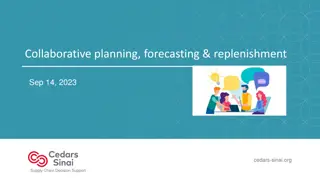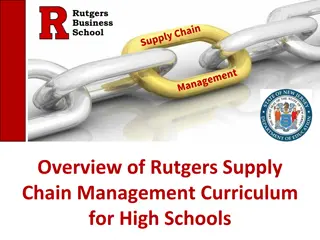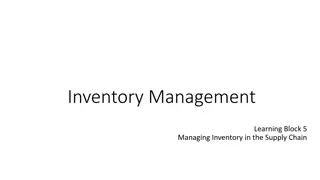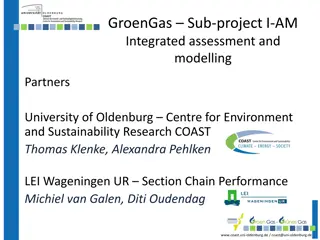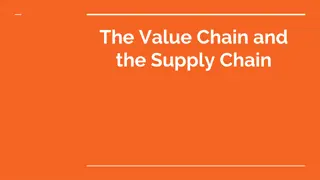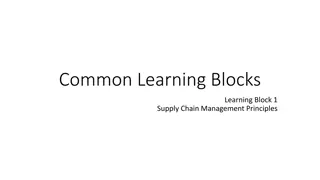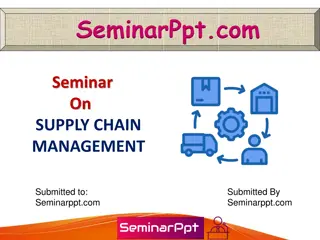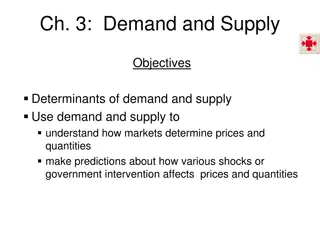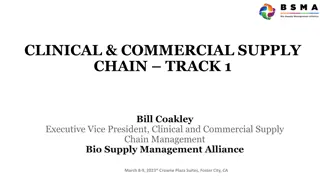Understanding Demand Planning in Supply Chain Management
Demand planning is crucial for company success, involving estimating anticipated demand, factors affecting demand, key roles and skills, and responsibilities. This process aligns organizations with expected demand, optimizes supply chain activities, and ensures sufficient resources to meet customer needs efficiently.
Download Presentation

Please find below an Image/Link to download the presentation.
The content on the website is provided AS IS for your information and personal use only. It may not be sold, licensed, or shared on other websites without obtaining consent from the author. Download presentation by click this link. If you encounter any issues during the download, it is possible that the publisher has removed the file from their server.
E N D
Presentation Transcript
Demand Planning Introduction to Demand Planning Learning Block 1 SCPro Fundamentals Training Program SCPro Fundamentals Training Program This material was funded in whole by a $24.5M TAACCCT grant awarded by the U.S. Department of Labor s Employment and Training Administration to the LINCS Consortium. Unless otherwise noted, this work is licensed under the Creative Commons Attribution 4.0 International License. To view a copy of this license, go to http://creativecommons.org/licenses/by/4.0/ on your web browser
Learning Block 1 Objectives After completing this learning block, you will be able to: Outline demand planning and why it is important to company success Discuss the factors that affect demand Explain the main approaches to planning and managing demand Identify the key roles and skills required in demand planning Discuss the key responsibilities and metrics used in planning demand
Learning Block 1 - Unit 1: Supply and Demand Planning Demand planning includes the steps and process taken to accurately estimate anticipated demand. Demand estimates include: anticipated orders orders received adjustments resulting from changes in inventory policies and actions
Learning Block 1 - Unit 1: Supply and Demand Planning Demand estimates are relied upon by other departments and are used to create: manufacturing schedules procurement plans inventory stocking policies. Essentially, you are working backwards from an end goal of selling your product (i.e. demand), using the goal to create enough product to fulfill the demand.
Demand Planning vs Supply Planning What s the difference? Learning Block 1 - Unit 1: Supply and Demand Planning Supply Planning supports Demand Planning and seeks to ensure enough resources to fulfill the demand Figure 1. Supply and Demand balance. Acquired from CanStockPhoto.com
Learning Block 1 - Unit 1: Supply and Demand Planning Demand planning involves anticipating demand, aligning entire organizations with expected demand for various products and services, and optimizing supply chain activity around expected levels of demand. Aim to: Correct inventory level sizes increase profit maximizing revenue Demand planning is not marketing and sales, but must understand sales and marketing plans to forecast demand.
Learning Block 1 - Unit 1: Supply and Demand Planning Supply planning involves ensuring that materials, components, consumables, and services are available to support the demand plan. Supply planning may take place in one or more departments. For example, some firms conduct supply planning in the manufacturing department, others supply plan in procurement, and even others have a defined formal planning department. There must be effective communication between Demand planners and supply planners YouTube Video: https://www.youtube.com/watch?v=RfZjikQ2nYs
Learning Block 1 - Unit 2: Factors Affecting Demand Several factors affect demand the market size complimentary products and services substitute products and services customer preferences future expectations income levels market forces risk events
Learning Block 1 - Unit 2: Factors Affecting Demand Market Size Larger markets naturally have a larger demand. The size of the market will fluctuate based on the product and consumers taste. E.g. if gas prices increase, the market for fuel efficient cars increases
Learning Block 1 - Unit 2: Factors Affecting Demand Complementary Products and Services Complementary products or services are typically associated with, or are natural components of, companies products or services. Change in price of a complementary product can change demand for a companies product. e.g. an increase in price of peanut butter may effect the demand of jelly.
Learning Block 1 - Unit 2: Factors Affecting Demand Substitute Products and Services Substitute products and services are similar to the product or service offered and satisfy the same need. Therefore they can be used in place of one another. Butter/Margarine Coke/Pepsi Tylenol/store brand
Learning Block 1 - Unit 2: Factors Affecting Demand Customer Preference Customers personal preferences for products can change from time to time and can be influenced by advertisements, promotions, and customer perceptions of the value of products or services. Running an extended sale on a product can negatively influence demand for competitor s products Uber and Lyft are impacting the demand for taxis by offering the same service, a ride, with a different experience that younger people prefer Demographic changes can shift demand for certain products As Baby Boomers age, products that appeal to or are necessary for the elderly will see a demand increase.
Learning Block 1 - Unit 2: Factors Affecting Demand Customer Future Expectations If consumers expect the cost of a product or service to increase in the near future, or if they expect it to become scarce for a period of time, they may buy more before the expected price increase or scarcity. These advance purchases would cause demand, and possibly prices, to increase. For example, an environmental event that negatively effects coffee crops leading to scarcity may cause people to stockpile coffee at a cheaper price.
Learning Block 1 - Unit 2: Factors Affecting Demand Income Consumers salaries and their relative increases or decreases over time impact demand for products and services. As consumers incomes increase, they may have more disposable income, and demand for certain products and services they purchase may increase.
Learning Block 1 - Unit 2: Factors Affecting Demand Shifting Commodity Markets Commodity markets, such as rubber, corn, gold, copper, and oil, are a real source of concern for many organizations because a primary characteristic of most commodity markets is that no single industrial buyer affects or controls prices within these markets. However, cartels of producers might attempt to manipulate world markets. Many commodities operate in markets that economists call pure competition. This means that prices are dictated by the market forces of supply and demand. For example, an increase in copper demand in China can result in higher prices for copper worldwide and for products that contain copper because of the resulting shortage of copper supply.
Learning Block 1 - Unit 2: Factors Affecting Demand Risk Events Types of Risk Events Global supply chains are vulnerable to many forms of risk, including natural disasters, terrorism, and currency fluctuations. These disasters can completely disrupt a supply chain and completely close an operation. Operational Risk Equipment failure, supply disruptions (company or supplier e.g. running out), labor issues, quality issues Natural disasters Earthquakes, tornados, storms Terrorism and political instability Commercial ship hijacking, supply route disruptions Commercial or market risk Supply/demand shifts, unexpected price changes
Learning Block 1 - Unit 3: The Demand Planning and Management Process The demand planning and management process involves balancing customers requirements with the capabilities of the supply chain. This includes forecasting demand and synchronizing it with production, procurement, and distribution capabilities.
Learning Block 1 - Unit 3: The Demand Planning and Management Process Planning Demand The demand planning process is typically initiated by marketing and sales, with input form other departments, to develop a strategic, company-wide forecast with more detailed steps and processes to arrive at an estimate of anticipated demand. Demand planning data considerations include anticipated orders orders received adjustments resulting from changes in inventory policies and actions The plan should span a horizon of 12-18 months
Learning Block 1 - Unit 3: The Demand Planning and Management Process Sensing Demand Demand sensing involves collecting information about demand based on real-time changes in demand. Demand sensing uses a broader range of demand signals, including current data from the supply chain and different mathematics to create a more accurate forecast that responds to real-world events Companies can use point-of-sale data and monitor social media to gather information about their products.
Learning Block 1 - Unit 3: The Demand Planning and Management Process Financial Plan Communicating Demand in a timely and structured manner is vital for an organization s success. Other plans are dependent on the Demand Plan Manufacturing Plan Demand Plan Supply Plan Production Schedule Sales Plan
Learning Block 1 - Unit 3: The Demand Planning and Management Process Shaping Demand Using price changes to influence demand a company can provide a discount on its products over a specified period of time to increase, or shape, demand. That company could also increase prices to decrease demand, if needed, when demand is greater than supply. Demand shaping involves influencing customer orders while also reducing the uncertainty of when those orders will occur. Though forecasts project the future, most shaping techniques rely on history as the basis of that projection.
Learning Block 1 - Unit 3: The Demand Planning and Management Process Shaping Demand Using price changes to influence demand a company can provide a discount on its products over a specified period of time to increase, or shape, demand. That company could also increase prices to decrease demand, if needed, when demand is greater than supply. Demand shaping involves influencing customer orders while also reducing the uncertainty of when those orders will occur. Though forecasts project the future, most shaping techniques rely on history as the basis of that projection.
Learning Block 1 - Unit 3: The Demand Planning and Management Process Managing Demand Demand management involves adjusting internal operations and plans to match demand or to shape demand as necessary. Respond to changes in volume, timing and mix of demand Supply demand increase (consider cost, capacity and capabilities) Stimulate demand when declining
Learning Block 1 - Unit 4: Demand Planning Roles and Responsibilities, Typical Reporting Structure, and Key Metrics Demand planners must have : Skills to communicate with cross-functional teams and communicate demand plans. Understanding of company reporting structures Skills to analyze data and adjust demand plans Raw material and commodity prices Restocking lead-times Knowledge of the business and industry Effect of marketing activities on demand Understand customer buying patterns International business experience (if working in international company) Skills to review demand plans to actual results and adjust accrodingly
Learning Block 1 - Unit 4: Demand Planning Roles and Responsibilities, Typical Reporting Structure, and Key Metrics Key Metrics Demand plan accuracy: This is the measure of accuracy of the demand plan over time. This measure is used to determine how closely the plan matches actual demand overall by key customers as well as the degree of variation of actual demand from the plan. Customer satisfaction: This measure includes on-time delivery and number of customer complaints. It is also used to determine the number of deliveries that were accomplished on time versus those that were not, as well as the amount and nature of customer complaints. Inventory performance: Days of inventory on hand # of days worth of inventory in stock to over normal usage Inventory turns (inventory velocity) Rate at which inventory moves through the distribution facility. Inventory costs money to hold, the quicker it turns, the less costly Dollar investment in inventory indicates the amount of investment that a company has occupied in inventory; this is a useful measure because inventory represents an investment of companies cash. The cash occupied in inventory cannot be used for other purposes.
Learning Block 1 Practice Questions 1. Demand planning ____________________. a) Includes the steps and the process to arrive at estimates of anticipated demand b) Includes the steps and the process to arrive at estimates of anticipated supply c) Is very seldom practiced by companies d) Only involves demand planners
Learning Block 1 Practice Questions 2. The number of potential buyers in a specific market for a given product or service will influence demand. If the market size ____________________. a) Increases, this can mean a lower number of potential buyers available to purchase a company s products or services b) Decreases, this can mean a lower number of potential buyers available to purchase a company s products or services c) Decreases, this can mean a higher number of potential buyers available to purchase a company s products or services d) Decreases, this can mean no potential buyers are available to purchase a company s products or services
Learning Block 1 Practice Questions 3. Complementary products or services are those products and services which ____________________. a) Are substitute products and services, which may exist for what a company offers b) Are given to customers to complement other products they purchase c) Are typically associated with, or are natural components of, the product or service the company provides d) Cannot have an impact on demand
Learning Block 1 Practice Questions 4. Consumers salaries, and relative increases or decreases in these salaries over time, ____________________. a) Do not impact demand for products and services b) Have no impact on the company c) Impact demand for products and services d) Do not matter to the demand planner
Learning Block 1 Practice Questions 5. A good demand planning and management process enables a company to be ____________________. a) Slow to react to changes in demand b) More agile in reacting to unanticipated demand c) More proactive to anticipated demand d) Both b and c
Learning Block 1 Practice Questions 6. Demand shaping is ____________________. a) The steps required to arrive at estimates of anticipated demand b) Measuring the rate at which inventory moves through a distribution facility c) The process used to influence demand d) A next generation forecasting method
Learning Block 1 Practice Questions 7. Demand management involves ____________________. a) Selling products to customers b) Placing orders for products c) Managing and prioritizing demand d) Providing discounts to customers
Learning Block 1 Practice Questions 8. A demand planner must have thorough knowledge of ____________________. a) Customer purchase patterns b) Purchasing tools and techniques c) Events that could affect demand patterns d) Both a and c
Learning Block 1 Practice Questions 9. A demand planner ____________________. a) Must be able to communicate effectively with colleagues in other groups affected by demand within the company b) Does not need to communicate with colleagues in other groups affected by demand within the company c) Only needs to communicate effectively with colleagues in the marketing and sales groups within the company d) Must be able to communicate with colleagues in the procurement group and seldom with the marketing and sales groups
Learning Block 1 Practice Questions 10. Demand plan accuracy is ____________________. a) A measure of the number and nature of customer complaints b) A measure of department performance c) A measure of inventory performance d) A measure of how accurately the demand plan matches actual demand
Demand Planning The Interaction Between Demand Management & Order Management Learning Block 2
Learning Block 2 Objectives After completing this learning block, you will be able to: Outline the key aspects of the order management function Discuss the key steps in the customer order and replenishment cycle Explain the key links between demand management and order management List the key technologies that enable e-Commerce Discuss the role of e-Commerce technologies in enabling effective demand management
Learning Block 2 Unit 1: Overview of the Order Management Function The customer order management function primarily involves handling customer orders and managing the customer order cycle. The order management process starts with customer requests, which can be general to specific requests about products or services. Customers can call, email, write or submit through the web, requests for: Product specifications Price Availability Potential discounts Inquiries may then be turned into orders and put into the order management system manually or through web input by the customer
Learning Block 2 Unit 1: Overview of the Order Management Function entering orders filling orders invoicing customers Customer Order Fulfillment The steps in ensuring that customers receive the correct products, in the correct quantity, at the correct time, and at the appropriate level of quality The ultimate objective of order fulfillment is fulfilling customers orders while satisfying promised delivery dates at the right quantities and conditions and while managing total costs. shipping orders tracking orders handling returns after-sale services
Learning Block 2 Unit 1: Overview of the Order Management Function Customer Order Fulfillment Similar to supplier selection and new product development, customer order fulfillment, if performed quickly and responsively, can lead to companies competitiveness. For example, a maker of beverage and ice dispensers might forecast and build a base product, anticipating customer orders. Final product configuration occurs only after actual orders are received, and this process might take only 3 days, compared to 4 to 6 weeks for their competitors; this extra time provides an advantage to the company against its competitors. Restaurants and other customers would purchase beverage dispensers because they plan to make a profit with them.
Learning Block 2 Unit 2: The Customer Order and Replenishment Cycle Customer request Customer order entry The customer order and replenishment cycle occurs when customers interact with suppliers (e.g., wholesalers, retailers, or material suppliers) and includes work directly involved in receiving and fulfilling customers orders and in replenishing inventories. Customer order fulfillment Customer order receipt Inventory replenishment Customer invoicing Stocking policies
Learning Block 2 Unit 2: The Customer Order and Replenishment Cycle Customer Request/Arrival The beginning of the order management cycle is when a customer requests product information Customer arrives at store Sales representative visits or calls Customer goes to website/showroom
Learning Block 2 Unit 2: The Customer Order and Replenishment Cycle Customer Order Entry In customer order entries, customers inform retailers and suppliers of goods about the products they wish to purchase. At a clothing store, customers might place items they wish to buy into shopping carts and bring them to the counter to check out and complete their purchases. Order entries can also include customers informing suppliers of the products and quantities they want to purchase online; orders are then transmitted to suppliers through the Internet. Orders must be accurate, timely and communicated throughout the supply chain.
Learning Block 2 Unit 2: The Customer Order and Replenishment Cycle Customer Order Fulfillment Customer order fulfillment includes the steps in ensuring that customers receive correct products, in the correct quantity, at the correct time, and at the appropriate level of quality. filling orders invoicing customers shipping orders tracking orders handling returns having after-sale services
Learning Block 2 Unit 2: The Customer Order and Replenishment Cycle Customer Order Receipt Customers receive and accept (or reject) their orders check for quantity and quality of delivered products incomplete or damaged orders are recorded by the customer in strong buyer/supplier relationships this is may be done through a computerized system to log orders that were received incomplete or damaged, and suppliers are then notified. customers typically withhold payment until deficiencies are corrected.
Learning Block 2 Unit 2: The Customer Order and Replenishment Cycle Customer Invoicing When customers place orders they receive invoices. at check-out counters, invoices are often presented as receipts or electronic invoices on check-out screens when orders are shipped to customers, invoices normally accompany the goods. Invoices state amounts owed and payment terms. Invoices are received by customers, checked against agreed terms and conditions between customers and suppliers, and paid accordingly (hopefully).
Constant replenishment Learning Block 2 Unit 2: The Customer Order and Replenishment Cycle Replace every item as it is sold Impossible to implement/costly to hold inventory Inventory Replenishment the process of determining when to make or buy more inventories and how many to order while also considering various cost and customer service trade-offs When do I need to refill my inventory? Stockout Run out of product Lost business
Learning Block 2 Unit 2: The Customer Order and Replenishment Cycle Stocking Policies Companies often base their inventory stocking and replenishment policies on their desired service levels. For instance, if a company wants a 98% service level, they must have enough inventory on hand to ensure that customers get the product they want in 98 out of 100 visits to a store or website. Marketing or sales personnel as well as inventory management personnel should work together to determine the correct service level for particular companies and products. Most marketing and sales personnel would like to have a 100% service level so that the company never stocks out of a product. However, this perfect service level is not typically feasible because it requires holding too much inventory at an expensive cost.
Learning Block 2 Unit 3: Demand Management and Order Management The Relationship Between Demand Management and Order Management It is critical for demand planners to have open communication with sales staff. Sales staff understand the timing of customer orders. If this information isn t communicated to the demand planners there may not be enough product to fulfill the orders See examples beginning on page 19 of the manual
Learning Block 2 Unit 4: e-Commerce Order Fulfillment Strategies Electronic commerce, or e-Commerce, is used to describe the wide range of tools and techniques used to conduct business without using paper. This form of commerce involves selling and buying goods and services using the Internet to transmit information and transfer funds. Automates the ordering process and efficiently processes orders accurately






